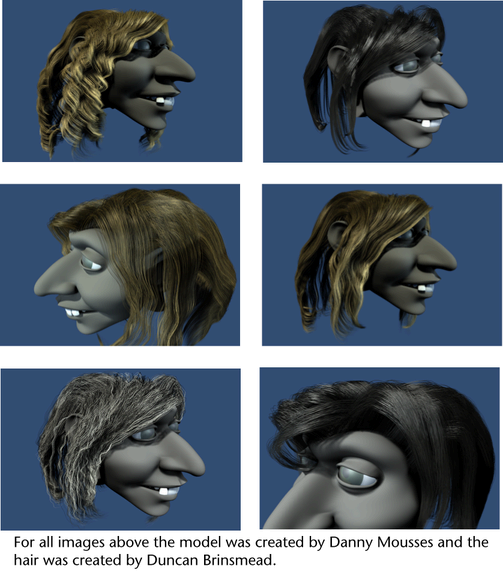With nHair you can simulate:
- natural movement and collisions of long hair
- hair blowing in the wind or being blow dried
- hair when swimming underwater
- various hairstyles, including ponytails, braids, and updos
- collisions between hair and character clothing
- other dynamic curve effects such as ropes, chains, cables, wires, a suspension bridge, sea creatures, or even a lofted surface from a curve. For more information, see Creating other models and effects with hair.
To get started quickly using Maya nHair, a tutorial is included with Maya. The nHair tutorial is one of the many comprehensive tutorials in the Maya Tutorials. To access the tutorial, select Tutorials from the Help menu.
nHair and Nucleus
nHair connections
A hair system is a collection of hair follicles. A NURBS or polygonal surface can have multiple hair systems on the same surface and one hair system can span multiple surfaces.
A hair follicle in human hair typically hosts one hair, whereas in Maya each hair follicle hosts a hair curve. The hair follicle controls the attributes and curves associated with a particular hair clump, and how the hairs attach to a NURBS or polygonal surface. The input to each follicle is a Start Position NURBS curve, a surface and a UV position to attach to.
When creating hair, the hair system output can be in the form of NURBS curves, Maya ®Paint Effects™ strokes, or both. If the specified output when creating hair is NURBS Curves, each follicle will contain one NURBS curve that represents the position of the hair in that follicle. If the specified output is Paint Effects, each follicle has a hair clump, made up of Paint Effects strokes.
There are various attributes on a hair system for modifying the look and behavior of the hair as a whole. There are also follicle level attributes that will override the hair system attributes; the visible result will be affected by both the follicle and hair system attributes.
nHair simulations are solved by the assigned Nucleus node. By default, hair interacts with the other Nucleus objects that are assigned to the same solver. These interactions include collisions and constraints between the objects. See Introduction to nDynamics.
nHair output
Consider outputting nHair to Paint Effects if you want to:
- render with the Maya Software renderer
- convert the Paint Effects hair to polygons and render in any renderer
Consider outputting nHair to NURBS curves if you want to:
- use the curves for output to another renderer that directly supports curve rendering.
- select a few Current Position curves and loft a surface through them with construction history.
- extrude a circle down the curve to create a tube.
- use the curves as path or control curves for any standard Paint Effects brush, such as feathers or vines. These brushes behave differently than the default built-in Paint Effects as the curves are not the hairs, but controls that interpolate and affect Paint Effects. This scenario is slower to update and takes a bit of time to set up. Alternatively, you could just assign a Paint Effects brush to a hair system (you don’t need NURBS Curves output for this).
Consider outputting Hair to both NURBS curves and Paint Effects if you want to:
- use both the curves (for example, as particle emitters to simulate spray flying off wet hair) and render using the integrated Paint Effects either directly or by converting to polygons.
Rendering nHair
Paint Effects hair can be rendered using the Maya Software renderer. You can also convert Paint Effects hair to polygons and render in another renderer, such as NVIDIA® mental ray®. Or you can output just the dynamic NURBS curves to an external renderer, such as Pixar® RenderMan®.
